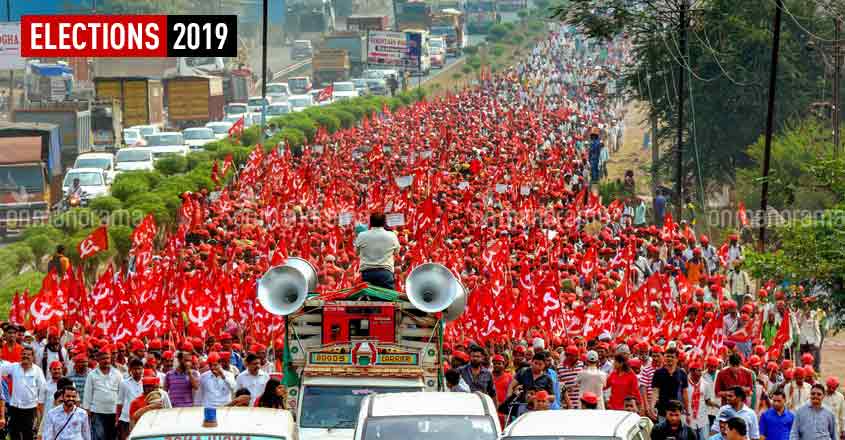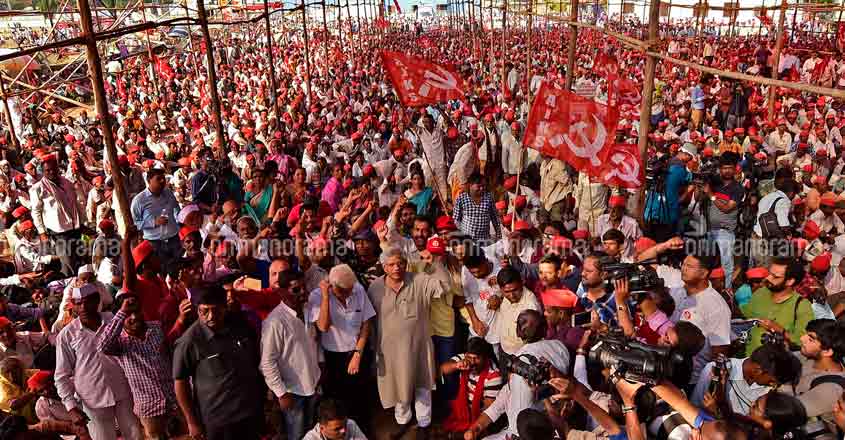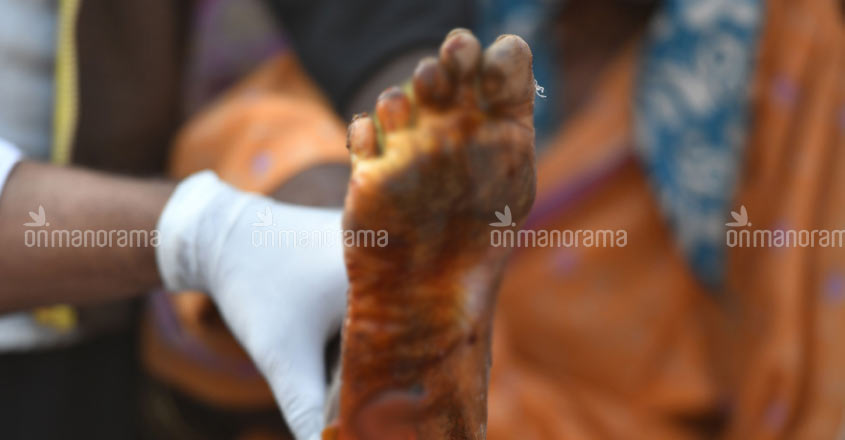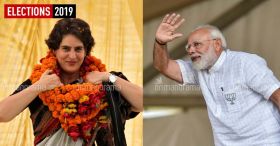
In the scorching March heat last year, tens of thousands of impoverished, landless peasants marched with rare resolve from Nashik to Mumbai making national headlines. The sight of the predominantly Adivasi men and women trudging the heated tar roads, their bare feet bruised and bleeding as they covered the daunting 200 km distance in seven days, stirred the conscience of the entire nation.
The #KisanLongMarch became the country's top hashtag on March 12, 2018, the day it arrived in Mumbai, with Indians of all hues pouring out their hearts on social media platforms expressing solidarity with their cause.
The marchers won many an urban heart with their decision to walk the last leg without a break, from 11am on March 11 starting in Thane city to 6am on March 12 when they finally reached the Azad Maidan, to avoid traffic snarls in south Mumbai and disruption of the SSC board exams.
The suggestion came from a leader named Jiva Pandu Gavit and was accepted unanimously by the marchers with a show of hands, their noble sentiments expressed in the memorable words, ‘It does not matter if we have to suffer some more, but we will not let our children in Mumbai suffer.’

This gesture drew unstinted admiration from people across the country; even prominent Bollywood and cricket celebrities expressed their appreciation. It soon turned into public anger against the callous and insensitive governments, both at the Centre and state, for refusing to address the economic injustice and social inequality that the peasant marchers were protesting.
Not wanting to be left behind, parties and organisations across the political spectrum came out in support of the red flag raised by the All-India Kisan Sabha (AIKS).
A year down the line, Gavit and his Adivasi peasant supporters have hit the road again. Only this time they’re testing the electoral waters in the Dindori Lok Sabha constituency that falls in Nashik district from where the largest mobilisation of peasants for the Kisan Long March came.
Nashik is also the home district of Gavit, a former AIKS state president, who has served as a seven-time CPI-M MLA representing the Adivasi dominated erstwhile Surgana and present Kalvan constituencies.
Gavit managed to retain the assembly seat even during the Modi wave in 2014, though with a wafer thin margin of 4,700-odd votes, thus making him the top hope for the CPI-M in Maharashtra for this year’s parliamentary polls. Dindori will be voting on April 29.
Gavit is pitted against the BJP’s Bharti Pawar and NCP’s Dhanraj Mahale in a region that voted in favour of the saffron alliance in 2014. Five of the six sitting MPs from north Maharashtra belong to the BJP while one is from the Shiv Sena.
The CPI-M and Kisan Sabha leaders will be hoping to ride on the wave generated by their unprecedented agrarian struggles against the Devendra Fadnavis-led BJP regime. After all, the striking images of farmers upturning milk cans on the roads and of Adivasi cultivators marching into Mumbai with their callused, bleeding feet, did generate a spontaneous outpouring of support and solidarity for the Left movement across the state, especially in their northern strongholds of Nashik and Thane-Palghar districts.

The other Left parties, like the Peasants and Workers Party (PWP) and CPI too came out in open support along with all the others except the BJP – viz Congress, NCP, AAP, MNS, Samajwadi, Republican, and even the Shiv Sena – during the Long March. Of course, the role played by the media and social media was a key factor for this unprecedented support from many unlikely political forces.
But much water has flown down the Godavari in Nashik ever since those heady days of Left struggles in Maharashtra during the last four years or so.
Fearing potential losses due to the agrarian discontent and the simmering dissatisfaction among Adivasis of the region, the BJP turned down candidature for Harishchandra Chavan, its three-term MP from Dindori. This led to internal squabbles within the ruling party causing the main opposition to sense an opportunity to improve their tally. While the Congress is hoping to win back the tribal Nandurbar belt bordering Gujarat and Madhya Pradesh, the NCP has raised the stakes in Dindori and Nashik, thus denying CPI-M a place in the alliance of progressives and liberals.
In Dindori, the NCP candidate was on number two and the CPI(M) was placed at number three in 2014. When the winner, BJP, denied ticket to its sitting MP favouring Bharati Pawar, a last minute defector from NCP, Sharad Pawar’s party chose to bring on board Dhanraj Mahale, a Shiv Sena leader until recently, refusing to leave the seat for CPI-M.

The unexpected turn of events left the party without a choice. The Congress’ decision to field its president Rahul Gandhi from Wayanad in Kerala also did not go down well with its state leadership. The CPI-M thus announced support to Prakash Ambedkar in Solapur, where he’s challenging Congress’ Sushilkumar Shinde, besides going it alone in Dindori.
Gavit and CPI-M could be hoping their struggles against the agrarian distress and drought that has affected all five districts in the region, would override the caste calculations on which their rival parties would be heavily banking upon. But how much the Maratha vs OBC vs Scheduled Tribes polarisation will impact on the final results will be known only after the vote count.
But it’s a fact that despite the State government’s farm loan waiver announced in 2017, a majority of the farming community remain dissatisfied due to its poor implementation on the ground. Local observers say agrarian crisis will be one of the strongest poll issues to go against the ruling government, especially in a largely rural constituency like Dindori. Even those who benefited from the loan waiver now stand at the threshold of debt, thanks to drought, they say.
The Adivasis in Dindori who marched to Mumbai in 2018 are all the more angry over the tardy processing of their Forest Rights Act (FRA) claims that could ensure them ownership rights over their traditional landholdings. “The government has totally failed to meet the promises made to the tribals. This is a serious issue, as is the agrarian unrest,” said Ashok Dhawale, leader of the CPI-M and the AIKS.

On March 12 last year, Fadnavis along with a group of select ministers and main opposition leaders, had held a three-hour discussion with the Kisan Sabha leaders in the Vidhan Bhavan before giving them written assurances. Three ministers had attended the victory rally at Azad Maidan publicly pledging to implement the agreement that had been reached and the chief minister had tabled it in the Assembly the next day.
The agreement included concrete time-bound actions to be taken by the government on AIKS demands concerning the implementation of the FRA, the river linking proposal adversely affecting tribals in Nashik, Palghar and Thane districts, loan waiver to farmers, mechanism for remunerative prices, vesting of temple lands, regularising houses on pasture lands, no land acquisition without consent, among others.
Besides these people’s issues, Gavit also has a huge personal stake in the parliamentary elections. Now nearing his seventies, Gavit has been in Maharashtra politics for long and is the only CPI-M representative in the current Assembly.
Before taking the political plunge, Gavit served as a muster assistant in the employment guarantee scheme and was active in the social field, where he was guided by Godavari Parulekar, a freedom fighter, writer, and social activist much influenced by Marx. He was elected an MLA for the first time after the Emergency in 1978, and has never looked back except for the electoral defeats in 1995 and 2009.

Elected pro-tem Speaker of the Maharashtra Legislative Assembly in 2014, his supporters attribute his success to his mass following and consistent work for the welfare of his remote, Adivasi-dominated constituency. Over 25,000 members of local tribes in the region have got ownership rights under the FRA while as many have enrolled in the Asram shalas or schools and colleges run by him, they claim.
He’s also been at the forefront of the agitations against the change in the river linking scheme that is to be launched in Nashik, Thane and Palghar districts. AIKS has demanded that the tribal villages not be submerged and that the water is made available to these districts and to other drought-prone districts in Maharashtra instead of diverting it to Gujarat.
For the CPI-M and the AIKS, the Long March last year and the electoral battles for both the Lok Sabha and the Assembly polls that follow in 2019, are an advance towards its aim of an agrarian revolution launched in the 1940s, whether it was Tebhaga in Bengal, Punnapra Vayalar and North Malabar in Kerala, Gana Mukti Parishad in Tripura, Surma Valley in Assam, East Thanjavur in Tamil Nadu and Warli Adivasis in the Thane district of Maharashtra.
The AIKS foundations were laid in Maharashtra in the second quarter of the twentieth century at the peak of the historic struggles against caste and landlordism led by Dr Babasaheb Ambedkar. Two of its prominent leaders, R B More and Shamrao Parulekar, who later joined the Communist Party, were the main organisers of the famous 1927 Satyagraha at Mahad in Raigad district led by Dr Ambedkar demanding the basic right of Dalits to draw water from the Chowdar Lake.
Dr Ambedkar and Parulekar also led a 8,000-strong peasant demonstration on the Mumbai Assembly in 1938 against the ‘Khoti’ system of landlordism that was then prevalent in the Konkan region. Remarkably, the peasants had all come to Mumbai by boat from the then Ratnagiri district of Konkan region.
The Long March in 2018 instead took to the road, but had succeeded in bringing the peasantry of Maharashtra together as a class, rising above the divisions of religion, caste and creed. “The massive peoples’ solidarity with it also cut across all these barriers. It showed that, in the last analysis, class struggle and class solidarity is the only way to fight back the dark forces of communalism and casteism,” wrote Dhavale on the party website, cpim.org.
For Dhavale, the massive response to the peasant struggles in Maharashtra in recent years could be attributed to the shocking numbers of farmers’ suicides since the advent of neo-liberal policies in agriculture started by the Congress government in 1991 and carried forward with great speed by successive Congress and BJP-led governments.
Maharashtra has the notorious distinction of being the largest ‘graveyard of farmers’, accounting for nearly 75,000 peasant suicides during the past 25 years or so.
The other burning issue in the state was the starvation of Adivasi children. Thousands of Adivasi children in the state, from Palghar to Nandurbar to Melghat in Amravati district, die every year due to malnutrition and starvation – a result of multiple factors such as landlessness and unemployment as well as the breakdown of the public distribution system and the health care system.
These two searing facts are enough to throw a blinding light on the deepening agrarian crisis and rural distress in the state, according to Dhavale.
However, the CPI-M and AIKS are aware that with the Kisan Long March one battle had been won, but the war still remains. A possible victory in the on-going electoral battle for the lone Lok Sabha seat it was fighting in the state, could provide a boost for broadening and intensifying the struggles of the Maharashtra peasantry, which has been a victim of neo-liberal policies since long.




